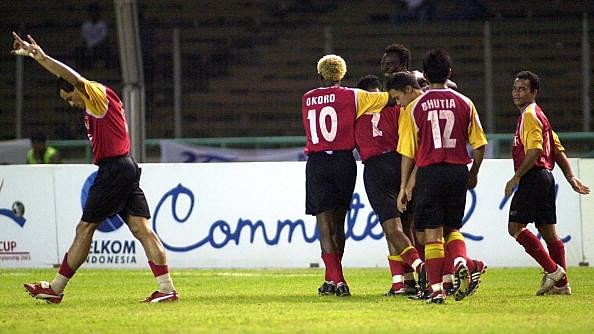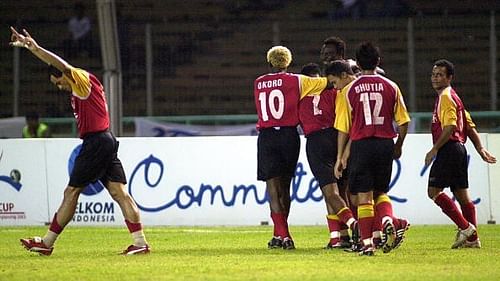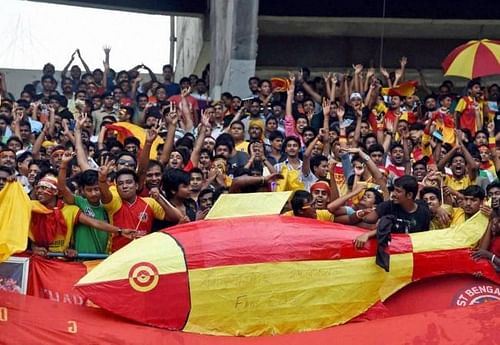
East Bengal's greatest hour

For East Bengal’s fans, July 26 will always be a day to cherish. On this memorable day in 2003, East Bengal became the first Indian club team to win a major international tournament, when they beat AFC Champions league finalists BEC Tero Sassana of Thailand 3-1 in the final of the LG-ASEAN Club Cup championships in Jakarta.
The Geloran Senayan stadium in Jakarta once again proved to be a lucky venue for Indian football. At this same stadium, India had won the 1962 Asian Games Gold medal beating South Korea 2-1 in the final.
East Bengal’s triumph and the manner of victory made Indian football fans dream of a grand future, which sadly did not materialize. But that fortnight in Jakarta, was a like a midsummer night’s dream for Indian football fans. It is undoubtedly the finest performance by an Indian club in the 21st century.
Dempo SC (Goa) reached the semi-finals of the AFC Cup in 2008 and East Bengal under Trevor Morgan did the same in 2013. But the quality of football that East Bengal displayed in 2003 in the ASEAN Club championships is unsurpassed. It is no wonder that in Kolkata East Bengal’s fans are celebrating the 12th anniversary of this memorable triumph.
The ASEAN Cup triumph was a win for Indian football and East Bengal, then the reigning National Football League champions. Meticulous planning led to success. The club officials allowed coach Subash Bhowmick a free hand in the selection of players to strengthen the squad for the 2003-04 season.
Internationals, Bhaichung Bhutia, Mahesh Gawli, Debjit Ghosh, Sur Kumar Singh, Bijen Singh and Raman Vijayan were recruited at the start of the season. Most of the previous year’s squad, which had won five major tournaments including National Football League (NFL), IFA Shield and Durand Cup, were retained.
East Bengal changed their pre-season training methods
Like professional clubs in Europe/Japan/S.Korea, the Calcutta club emphasised on pre-season training and improving fitness levels. The players stayed in a five-star hotel in Kolkata, with access to a gymnasium and sauna baths for six weeks. The rigorous training by the South African trainer Kevin Jackson made the 2003-04 East Bengal squad the fittest ever football team in India.
It was Bhowmick who persuaded sponsor (Kingfisher) Vijay Mallya to improve the annual sponsorship from Rs. 1.50 crores to Rs. 2.25 crores. This extra money helped to pay Jackson his fees of $1,000 per week and give the players improved facilities.
Bhowmick’s vision has to be complimented. He was watching cricket on TV and realized that the Indian team was slim and trim and there was not an ounce of fat on Sourav Ganguly or Sachin Tendulkar or any of the others. He made enquiries and realized that this extra fitness was not just due to John Wright (then coach of India) but the work of the South African fitness trainers.
East Bengal as national league champions of India had been invited to play in the LG Cup for the ASEAN Club championships in Indonesia from July 12 to 26. He felt that he had the squad to excel, but they needed special training and fitness. So he made plans to get a foreign trainer which set a trend in Indian football. After East Bengal’s ASEAN Cup success, Mohun Bagan appointed a Brazilian fitness trainer in 2003.
The ASEAN Club championship was played on a league cum knockout format. East Bengal was placed in group D along with BEC Terro Sasana(Thailand) and Armed Forces FC of Philippines. East Bengal lost their opening tie 0-1 to the Thailand league champions on July 14.
Bhaichung leads Bengal’s recovery in the second group match with a double hat-trick
Two days later they bounced back in style. Playing exhilarating attacking football, with most of the moves initiated by Brazilian midfielder Douglas D’Silva, East Bengal beat Armed Forces F.C. Philippines 6-0 (Bhaichung scored all six goals, the first Indian to achieve a double hat-trick in international football). East Bengal reached the last eight as the second team from Group D.
In the quarter-final, on July 21, the National League champions of India overcame Indonesia's top club Persita Tangerang 2-1 in a battle of attrition. Bhutia put East Bengal ahead in the 54 minute, but Illham Jaya Kusuma equalised in the 66th minute. Winger Bijen Singh scored the match winner in the 77th minute.
On July 24, East Bengal took on Indonesia’s league champions Petrokimia Putra in the semi-final. The local club had massive support and curtailed East Bengal’s fluency. Petrokimia led by a 23rd-minute goal by M. Jaezal Ichwan. At half-time, pep talks by both Bhowmick and Bhutia revived East Bengal’s morale. The team played more attacking football and Bhutia equalised at the hour mark.
The match ended 1-1 after extra time. In the resultant penalty shootout, the scores were tied 4-4. For East Bengal, the Mizoram winger S. Malsawmtlunga shot over the bar.
There was mounting tension in the sudden-death session. East Bengal took their kicks first so Petrokima was always playing catch up. Douglas, Surkumar Singh and M. Suresh converted for East Bengal. Goalkeeper Sandip Nandy made a heroic save of the third penalty kick in the sudden death session and East Bengal prevailed (1-1) and 7-6 in sudden death penalties in the semi-final.
The Kolkata club had some misfortune as defender Mahesh Gawli was ruled out of the final with a double yellow card and Debjit Ghosh was injured.
The final was on Saturday, July 26, 2003. The Thailand league champions had a psychological advantage having beaten East Bengal in their league encounter. But Bhowmick’s tactical planning and Bhutia’s mental toughness gave East Bengal confidence. On the eve of the match, Baichung set about convincing his teammates that they could, in fact, win the final.
The Big Final
Bhowmick’s dilemma was whether to include striker Mike Okoro in the playing eleven in the final. Okoro had missed most of the match due to sickness. Now he was fully recovered and Bhowmick felt that his blistering pace could give East Bengal the cutting edge in the final. He proved quite clairvoyant.
In the 26th minute, Alvito D’Cunha gave a delectable through ball and Okoro surged past the BEC Terro Sasana defence and scored. Bhutia played the game of his life in that final and scored what I consider one of his best goals, shoulder charging an opponent to gain possession, evading a defender and placing past the advancing goalkeeper just three minutes into the second half. At that stage, East Bengal led 2-0 and an upset win was on the cards.
The Thailand team started dominating possession with their superb passing. They halved the margin in the 58th minute through midfielder Panai Kongpapan. Bhowmick was fretting in the dugout as his team was getting over-run in midfield. He replaced defender Deepak Mondal with Shlyo Malsawmtlunga to stem the midfield domination of his opponents.
Still the Thailand team surged forward and it was only some heroic work by skipper Suley Musah, M. Suresh, Surkumar Singh and Douglas that helped East Bengal survive.
Bhowmick was contemplating further changes when Alvito scored a miraculous goal in the 69th minute. A predominantly left-footed player, Alvita only used his right foot as a balancing factor. He received a ball on his right foot at the top of the 18-yard box. Realising he had no time to relay the ball to his favourite left foot, Alvito let fly with a crisp low right-footer which bulged the net.
This was the turning point of the match as East Bengal held on for a memorable 3-1 win. Baichung Bhutia emerged as the top scorer of the tournament with nine goals and was declared man of the match in the final. East Bengal received $50,000 for winning this coveted championship.
The East Bengal players received a hero’s welcome back home

On their way back after the final, East Bengal had a stop-over in Singapore. The players went shopping and sight-seeing to relax after their strenuous win. Baichung, a consummate team man despite his super-star status, treated the entire squad to a sumptuous lunch at the famous restaurant in the Little India market in Singapore.
East Bengal’s 2003 ASEAN Cup victory had a triple benefit for football in India. It revived the mass hysteria for football in Calcutta, increased the following of the game in India and enhanced our image in Asian football. Thousands of delirious East Bengal fans thronged the Kolkata airport to greet their heroes when the team landed clutching the ASEAN Cup.
The squad was felicitated and hailed in the local media as giving a new direction to Indian football. Creditably this victory was hailed in the national media also. There were programmes on several TV channels highlighting this victory. Social media had just taken off in India and by the use of e-mails this victory was highlighted by East Bengal’s fans all over the world.
Coach Subash Bhowmick was hailed as a visionary for his meticulous planning, eye for talent and team-management skills. Buoyed by this victory, Bhowmick put forth several revolutionary ideas. He told the club management, that to increase the global brand of East Bengal; they should play more international club tournaments and shun traditional domestic competitions like the Durand and IFA Shield.
Indian players were in demand after the tournament
Foreign clubs were on the look-out for Indian players. Bhaichung Bhutia went on loan for two months (August 15-October 15) to Malaysian league champions Perek F.C. Besides paying Bhaichung, the Malaysian club also gave East Bengal $10,000 as compensation. Thailand league champions BEC Tero Sassana sought to procure the services of young defender Sur Kumar Singh and striker Mike Okoro.
Others in demand were forward Alvito D'Cunha and defenders Mahesh Gawli, M. Suresh and goalkeeper Sandip Nandy. So the Jakarta ASEAN Club Cup victory provided Indian players greater international exposure and further popularised the game in India.
Bhowmick’s vision for East Bengal did not materialize. Just five days after their memorable triumph the club had to play in the 25th Tata Federation Cup, held in Kolkata. The coach wanted to field a second-string side, but the management did not agree. East Bengal beat HAL Bangalore 5-0, but in the quarter final on 4 August were upset 0-1 by Vasco.
It was all downhill after that. Later in August, on a soggy, muddy pitch, ace playmaker Alvito developed knee trouble and was ruled out for the season. East Bengal reached the final of both the IFA Shield and Durand tournament but lost on penalties to Mohun Bagan (3-5) and Salgaocar(3-4) respectively. The aura of invincibility after the ASEAN Cup successes had faded.
East Bengal started their 6th NFL campaign on a shaky note but was revived by the excellent combination of Bhutia and the late Cristiano Junior (the Brazilian striker who joined them in December 2003). These two combined brilliantly and they retained their national league and also became the first Indian club to win their group and enter the AFC Cup quarter-finals in May 2004.